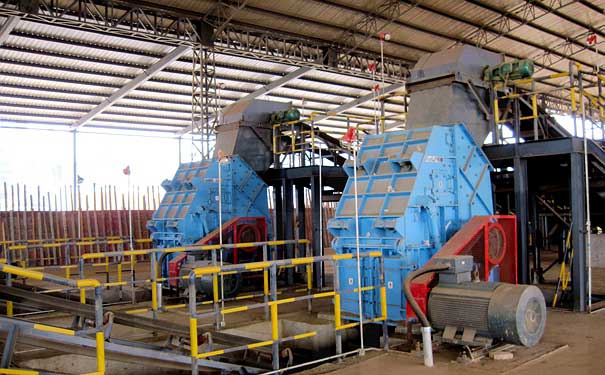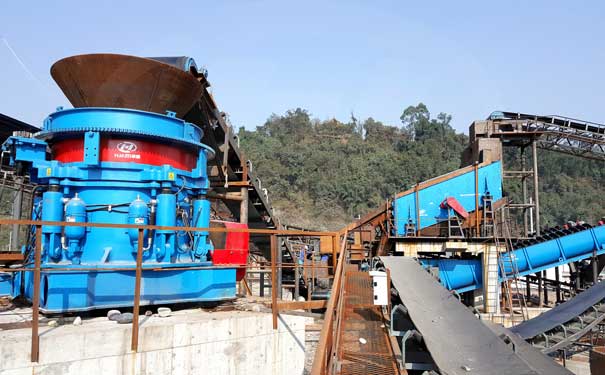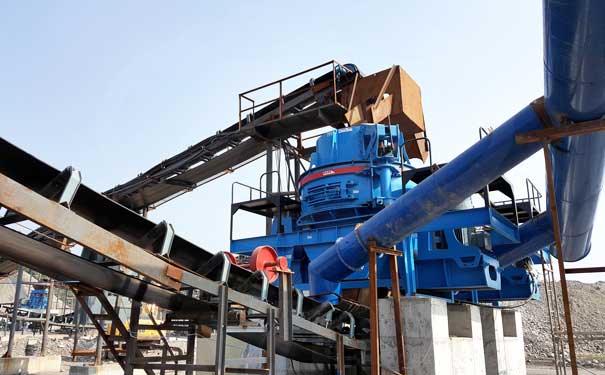The machine-made sand equipment mainly consists of a crushing system, a screening system, sand making system, a storage and delivery system, and a dust removal system. The crushing system plays a pivotal role as a link in the production process, and the advantages and disadvantages of different crushing equipment combinations. There is a clear difference principle of crushing equipment selection. The crushing system is mainly composed of coarse crushing, medium crushing and fine crushing (shaping). The selection of equipment should be determined by comprehensive consideration of material characteristics, product shape and market demand. The typical crushing processes are as follows:
1. Composed of hammer crusher and screening system
Advantages: simple process, easy maintenance and management, less land occupation, low project investment, and low energy consumption per unit product.
Disadvantages: the product variety ratio is not easy to adjust, the adaptability to ore is poor, and the scope of use is narrow; the product has poor grain shape, large amount of fine powder, low product acquisition rate; large dust collection air volume required by the crusher; high consumption of wear parts; It is mainly used in cement companies that share mine crusher cement and aggregate production lines, and specific ore new production lines.
2. Composition of jaw crusher, impact crusher and screening system
Advantages: The system has many specifications, can be large-scaled, and has a wide range of applications; the product variety ratio is easy to adjust, and it is suitable for materials with medium abrasion index.
Disadvantages: higher energy consumption per unit product; poor adaptability to ore with high abrasion index, medium product shape, medium acquisition rate of coarse aggregates; large dust collection air volume required by the crusher; higher consumption of wear parts than cone crusher.
3. Composed of jaw crusher, cone crusher and screening system
Advantages: easy adjustment of product variety ratio; suitable for materials with high abrasion index; good product shape, small amount of fine powder, high rate of obtaining coarse aggregates; small dust collection air volume required by the crusher; low energy consumption per unit product , low consumption of wear parts.
Disadvantages: Three-stage crushing or more crushers are required when the system capacity requirements are large. At this time, the process is complicated and the project investment is high.
4. Jaw crusher + impact crusher + vertical impact crusher (sand making machine) and screening system
The process is basically the same as the jaw crusher + impact crusher system, except that the vertical impact crusher is added to reshape the aggregate to meet the needs of high-quality aggregate customers. In addition to the advantages and disadvantages of the jaw crusher + impact crusher system, this system also has the following characteristics:
Advantages: Multi-quality aggregates can be provided to meet the needs of different customers. The vertical shaft crusher produces more fine powder and can take into account the production of machine-made sand.
Disadvantages: complex process, high project investment; high energy consumption per unit product.
Whether the equipment selection is reasonable is the primary factor that determines the success of a production line. The equipment selection of the aggregate production line mainly depends on the physical properties of the raw materials (such as the hardness of the raw materials, abrasiveness index, soil content, etc.). With the impact of the current environment on the sand and gravel industry, the aggregate industry is gradually developing in terms of scale, environmental protection, ecology, and sustainability. If you want to configure reasonable and efficient sand and gravel production line, you must consult a professional crusher manufacturer.






